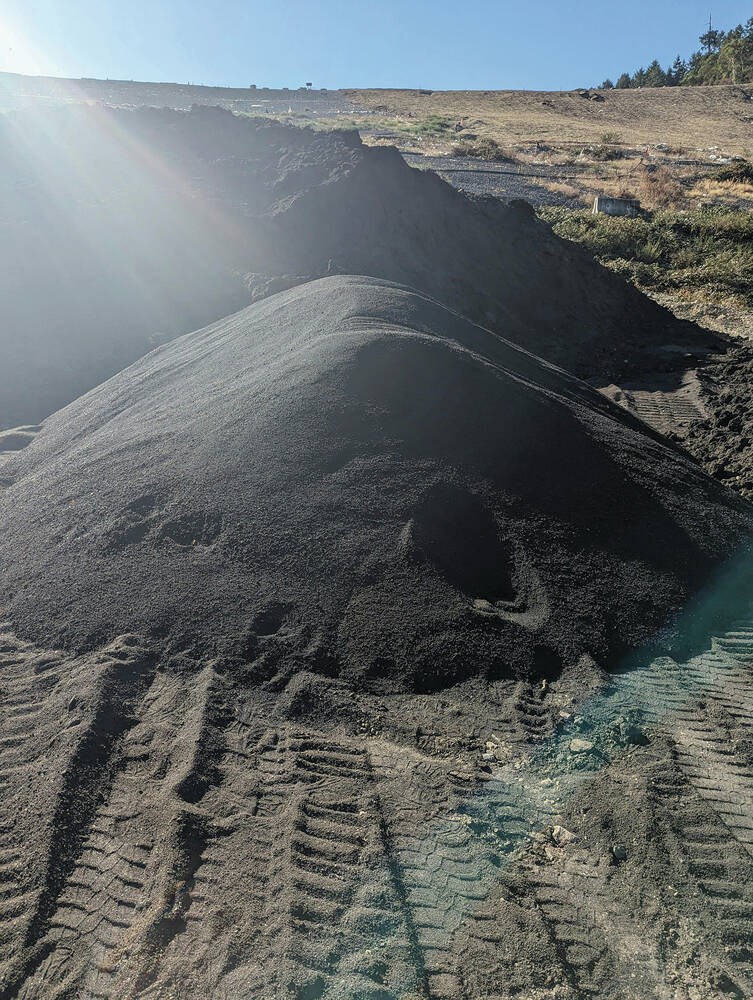The biosolids are piling up in the Capital Regional District with few options in the short term other than Hartland Landfill to bury the remnants of sewage treatment.
Of the 2,908 tonnes of biosolids produced last year, the CRD put 2,233 tonnes into controlled-waste trenches in the landfill with other hazardous materials. About 680 tonnes were shipped to a quarry reclamation site in Cassidy, south of Nanaimo, and the remainder — just 67 tonnes — went to the on-again, off-again operations of a Lafarge cement facility in Richmond to fire its kiln.
Now the CRD is talking with another Nanaimo-area private quarry about taking some more biosolids, which isn’t sitting well with its counterparts to the north.
“It limits our options with our own beneficial-use strategy [for biosolids],” Vanessa Craig, chair of the Regional District of Nanaimo, said in an interview Thursday.
She said the Nanaimo district has a successful land-application strategy in its own region and suggested the CRD do the same, adding that trucking the biosolids north only adds to greenhouse gas emissions.
In a letter to the CRD board last month, Craig requested the “CRD board cease considering land application within the RDN as a viable option for biosolids generated in the capital region.” The letter said Nanaimo is concerned that the CRD’s activities may limit the district’s options as its population continues to grow.
Nanaimo has been using biosolids as fertilizer on forested lands for about 30 years. The district currently spreads its sewage treatment residuals through a fertilization program on private lands managed by Mosaic about 12 kilometres northwest of the city, and has recently moved on to a new application site eight kilometres to the south known as Blackjack Ridge along Nanaimo River Road and the Nanaimo Lakes.
Craig said there are no other sites currently identified for future applications, so any quarries in their region that can take biosolids would be useful for future inventories. “We are trying to be productive within our own region and mindful of what we use [biosolids] for in the future,” she said. “We have to have that flexibility for sites in our own region.”
The CRD is currently directing about 10 tonnes of biosolids into Hartland every day as options like the cement kiln whither.
The CRD said staff continue to seek additional short-term options consistent with the board’s direction, including out-of-region and landfill applications.
The scenario of putting biosolids in the dump is gathering urgency after news this week of a lawsuit launched by five Texas farmers who allege fertilizers made from biosolids produced by Synagro Inc. in that state permeated wells and surface water and is making them sick and killing their farm animals. The allegations claim the biosolids fertilizer contained high levels of per- and polyfluoroalkyl substances, a group of human-made chemicals that don’t break down in the environment and some studies suggest cause cancer and other medical issues.
The allegations haven’t been proven in court. Synagro operates the residuals plant at Hartland, but does not market fertilizers here.
Larisa Hutcheson, manager of parks and environmental services, said the biosolids dumped in Hartland are mixed with sand and monitored for leaching.
The CRD board has requested a meeting with B.C.’s Environment Minister George Heyman to discuss an extension on finalizing its long-term management plan.
The province requires that the CRD submit the plan by June 18 and have it in place by Jan. 1, but it’s awaiting a provincial update to regulations that govern biosolids, which is expected in May. The province created a technical working group to identify new scientific information on emerging contaminants of concern in biosolids.
Class A biosolids must meet regulatory requirements set by the province through the Organic Matter Recycling Regulation, which dictates maximum allowable levels of pathogens and contaminants like heavy metals to ensure protection of human health and the environment. These regulations also provide strict controls on how and where biosolids may be used.
In a letter to the environment ministry on Tuesday, CRD chair Colin Plant said its long-term management plan has included analysis and a public consultation period, which closed earlier this month, on all available beneficial reuse options, including thermal processing and land application scenarios such as reforestation and agricultural fertilizer.
“The CRD board anticipates that the findings of the working group report will help us make an informed decision on biosolids management,” said Plant.
The board also passed a motion at its March 12 meeting to initiate an academic analysis by directing staff to move forward with a third-party academic review of the scientific literature on the uses and impacts of biosolids.
Plant said the CRD continues to receive correspondence and delegations from the public expressing concerns regarding the potential for human health and environmental impacts resulting from the presence of contaminants in biosolids.
“It is my hope that the [province’s] report or a third-party academic review would help address these concerns,” said Plant. “It is the CRD’s intent that a CRD-funded third-party academic review will complement, not duplicate, work already undertaken by the ministry.”
The CRD said biosolids are commonly used within communities across Canada, and around the world; mostly land-applied to add nutrients and organic material back to the land, but also thermally processed and some land filling.
It said other large communities like Kelowna, Kamloops, Comox and Metro Vancouver primarily use their biosolids as fertilizer or in compost.
There are currently no full-scale advanced thermal facilities processing biosolids in Canada. The CRD is advancing a pilot project utilizing thermal technologies to process biosolids. A request for expressions of interest garnered 10 replies and six have been invited to submit proposals.
But even if a thermal processing pilot proves successful, it will take up to a decade before a functioning plant can be used as part of a long-term biosolids plan, the CRD said.
>>> To comment on this article, write a letter to the editor: [email protected]



